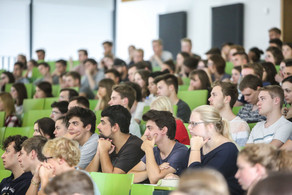"Best Paper Award" for Contribution on UWB-Based Indoor-Navigation for Robotic Applications
- News
- CPS.HUB
Facts and link to the awarded article:
J. Tiemann, C. Wietfeld, "Scalable and Precise Multi-UAV Indoor Navigation using TDOA-based UWB Localization", In 2017 International Conference on Indoor Positioning and Indoor Navigation (IPIN), Sapporo, Japan, September 2017.
Abstract - Ultra-wideband wireless positioning technologies based on IEEE 802.15.4a have gained attention for various use cases requiring highly precise localization. Multi-rotor unmanned aerial vehicle (UAV) systems provide several sensors for stabilization and navigation. However, absolute indoor positioning poses a problem for autonomous robotic systems. The specific challenge addressed in this paper is enabling novel applications with autonomous UAV systems through tight integration with scalable and precise receiver-side time-difference of arrival (TDOA) based ultra-wideband (UWB) indoor localization. For the in-depth validation of the proposed approach, several experiments are performed. One proves the repeatability of the proposed method by following a predefined trajectory ten times achieving close to optical motion-capture based control performance, with a 3rd quartile of the alignment error lower than 10 cm. Another experiment addresses the simultaneous flight of three UAVs in close proximity and delivers an analysis of the real-time capabilities which in turn proves the multi-user scalability. The last experiment demonstrates a user-interactive application of the proposed approach in a logistics environment. A video along with the raw samples, reference data and processed positions of the aforementioned experiments is provided alongside this work.






